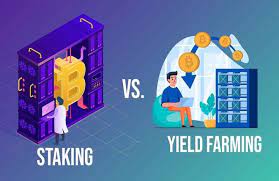Decentralized Finance (DeFi) has opened the door to new ways of earning passive income with your crypto assets. Two of the most popular methods are yield farming and staking. While they both let you put your digital assets to work, they function in different ways and come with their own benefits and risks. Let’s break it down in a simple way.
What is Yield Farming?
Yield farming is like lending your crypto to a decentralized platform in exchange for rewards. When you provide liquidity (usually by depositing tokens into a liquidity pool), other users can trade or borrow those tokens. In return, you earn interest, trading fees, or governance tokens.
Think of it as a digital version of renting out your assets—you still own them, but you let others use them temporarily and collect rewards. However, yield farming can be complex and often involves moving funds across multiple protocols to maximize returns.
What is Staking?
Staking, on the other hand, is much simpler. You lock up your crypto in a blockchain network that uses a Proof-of-Stake (PoS) system. By doing so, you help secure the network and validate transactions. In return, the blockchain rewards you with more of the same token.
It’s similar to putting money into a savings account that pays interest, except instead of a bank, you’re supporting a decentralized blockchain.
Key Differences
Complexity
Yield farming requires active management, while staking is more straightforward.
Risk
Yield farming can be riskier due to volatility and smart contract vulnerabilities. Staking is generally safer, but it depends on the blockchain’s stability.
Rewards
Yield farming can offer higher returns, but staking provides more predictable earnings.
Final Thoughts
Both yield farming and staking have become pillars of the DeFi ecosystem. If you want higher rewards and don’t mind managing risks, yield farming might suit you. If you prefer a “set it and forget it” approach, staking could be the better choice. Either way, always research the platform before locking in your funds—crypto rewards can be tempting, but safety comes first.

